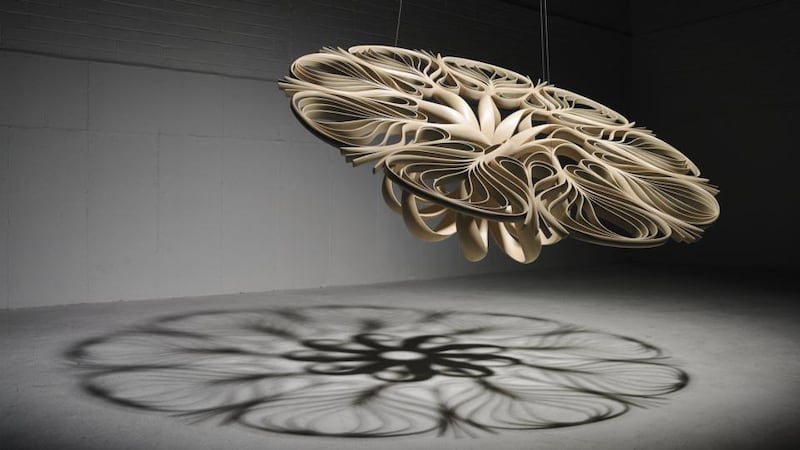In the first or second week of November, Park Avenue in New York will close to traffic for the day to allow a piece of Irish furniture to be craned up to a private apartment in Manhattan. The table is the work of the precociously talented Kinsale-based furniture designer Joseph Walsh. Walsh is rapidly earning an international reputation for his sweeping curvilinear forms in ash that challenge technical boundaries, but whose conceptual ideas are firmly rooted in nature.
This has been a year of extraordinary growth for him, with commissions flowing in from all corners of the world. This month he is showing in Paris at the Biennale with another studio maker. In October he exhibits a series called Lilium in the Oliver Sears Gallery, Dublin – four finely worked pieces in bulb-like forms (using six kilometres of ash) that take on more freeform shapes. A new 21’ “infinity” version of his acclaimed Enignum bed heads to Chatsworth, the Duke of Devonshire’s estate in Derbyshire, early in 2015.
His flamboyant, large-scale Magnus Celestii spiral exhibited in Wiltshire last May returns to Ireland for an exhibition in Kilkenny and a new large-scale piece travels to the Museum of Fine Art in Boston next year. Many other museum exhibitions loom on the horizon. People are now comparing him to some of the great masters of American furniture while influential tastemakers such as Jack Lenor Larsen, Peter Marino and Jacques Grange keep him on their powerful radars.

Furniture as art
Fine art fairs have expanded in recent years to include furniture, interior design and architecture as collectors look for design pieces as they would for sculpture or works of art. "Furniture is like a decorative art. You live with it," a Sotheby's spokesman recently told the New York Times. Walsh has benefited from this phenomenon which has seen prices for furniture range from €2,000 to €600,000.
Self-taught, Walsh started learning about woodwork at the age of eight from his grandfather, James Duignan, and was 20 when he founded his studio and workshop in Cork. His big breakthrough came in 2008 with a solo show in New York that resulted in a number of commissions and an invitation to show at PAD (Pavilion of Art & Design) in London. His signature flourish of form – curvaceous, sinuous, ribbon-like shapes, intricately worked in thin layers of ash – make for some spectacular pieces of furniture.
In the studio
His workshop/studio in Riverstick, near Kinsale, is a converted potato barn in a beautiful setting with a restored thatched house at the entrance where his aunts once lived.
“We have control of the environment and space here,” he says as we sit in the orchards behind the studio. These surroundings, central to his creative process, house the studio’s research and development. Growing up on the farm, making things was taken for granted, he says. “It is great because you have these reference points. It keeps your feet well on the ground, but gives so much back.” He now employs 14 craftworkers, half of them from Ireland with other specialists from Argentina, Japan, France, Portugal and Israel.
He has been experimenting with resin, testing it for tensile strength and using it instead of glass for table tops with interesting textural results. “There is fluidity in the process, so there are no fixed expectations of what will form in the process so there is openness and surprise,” he explains showing how a 3D effect is created by the resin making for more visual interest and detail than plain hardened glass.
Marble move
A significant new development, however, has been his use of Connemara marble that will radically change its popular association with small tourist gift items. In its heyday in the early years of the last century, the marble was used architecturally in all its grandeur gracing interiors like the great columnar entrances to the University Club in New York, the Ashmolean Museum in Oxford and many cathedrals.
Confessing to “an incredible appetite for solutions”, Walsh’s use of marble is a further example of his fearless approach to material. Work with the stone, quarried from Kevin Joyce’s mine in Lisloughter, near Recess, started two years ago and presented considerable challenges, the first being Walsh’s desire for a variety of colouration in a single piece of furniture.
He and his team then developed complicated engineering technology in association with Ove Arup allowing resin and marble to fuse. The end result is a dramatic and beautiful table composed of two intersecting carved marble pieces that appear to float on resin. This will be shipped to New York in November to the Salon of Art & Design. Despite it being the most expensive piece Walsh has crafted at €250,000, three have already been sold.
“For a small studio, this is very sophisticated and has taken all the intensive work of our hands-on approach combined with scientific and engineering expertise [to achieve]. The development has been extraordinarily expensive. It feels like gambling, but the results have paid off,” he says.
He is already working on plans for 2016 and moving away from making the furniture himself.
“I design and direct the team and am giving design ownership to the maker of the piece. They are open to my direction and that’s where it’s at. We are thinking long term and yet dealing with the day to day. Right now circumstances have come together on these projects, but there are a lot of things yet to be realised.”
Joseph Walsh’s Lilium exhibition runs at the Oliver Sears Gallery, Molesworth Street, Dublin, from October 9th to November 27th









